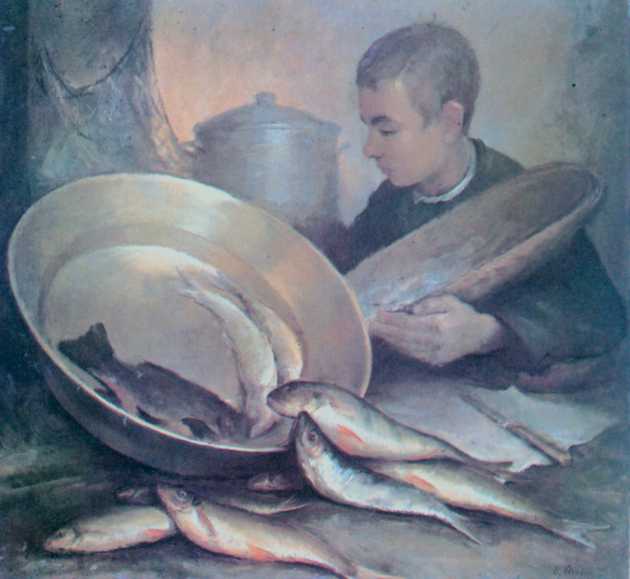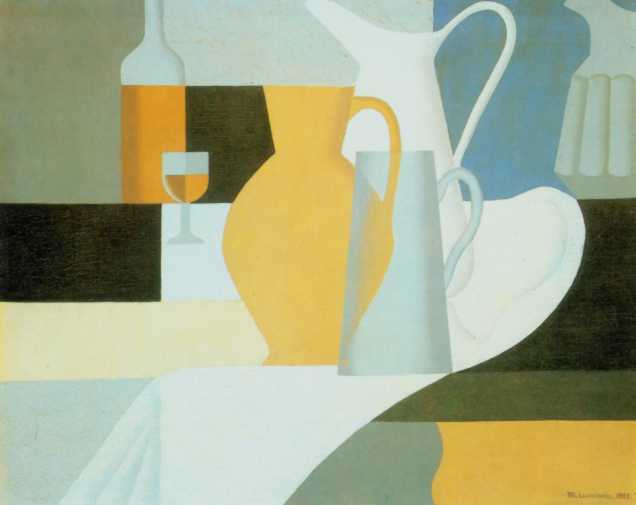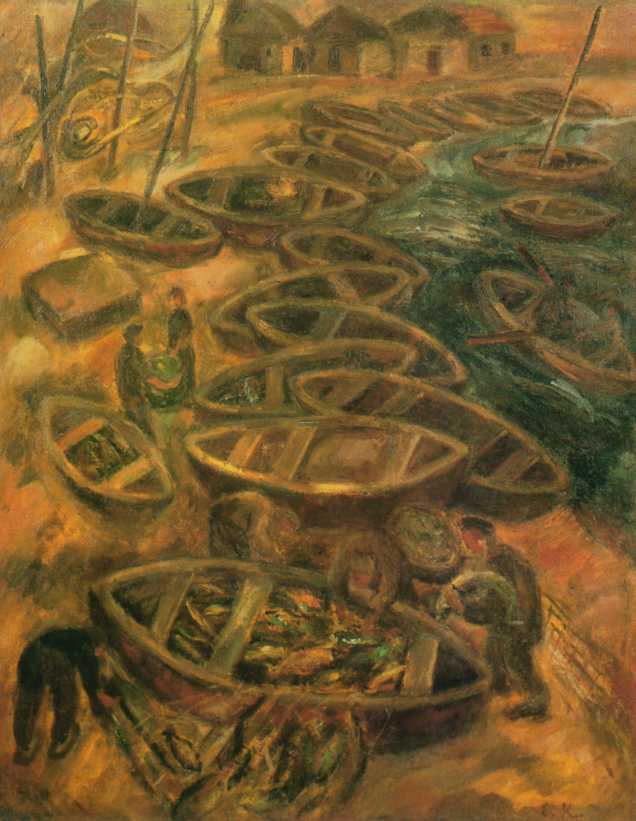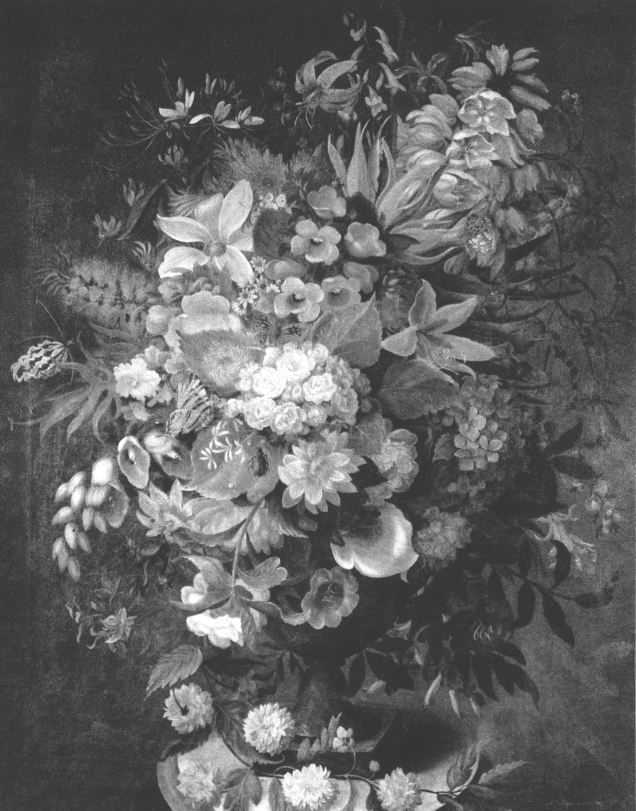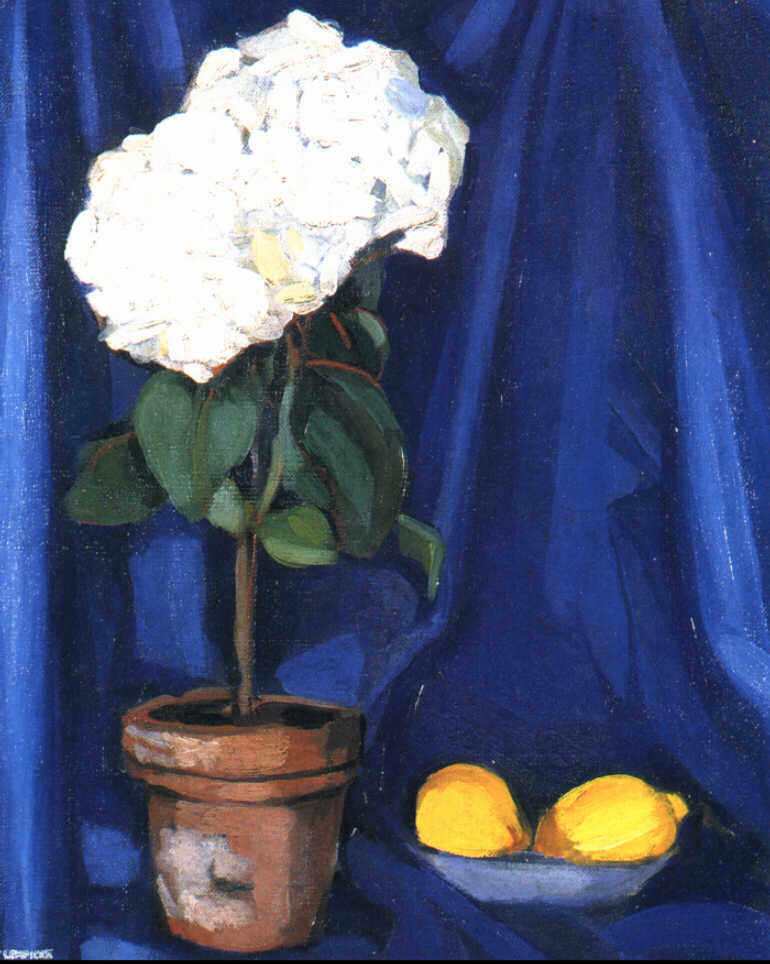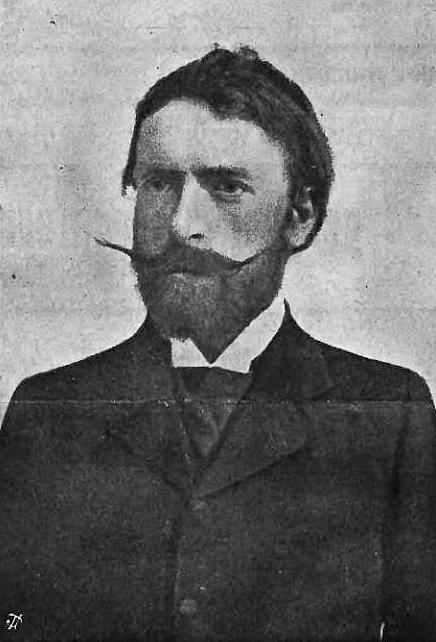Bellotto, Bernardo (ur. 30.01.1721 Venice, zm. 17.11.1780 Warsaw).
Nephew and student of Antonio Canal called. Canaletto, from which he took the nickname. Antonio is known in his homeland until today under this nickname, in Western Europe and the United States, and Bellotto in Germany, Austria and Poland, which often leads to misunderstandings.
Belotto left the Venetian studio of his uncle after several years of study in the early 1840s. already as a highly educated artist. The real or fantastic architectural view and workshop methods were taken over from Canal's theme of paintings, consisting of, among others. on the use of an optical instrument. camera obscura for making drawings from nature and painting based on these drawings in the studio, finally, the painting style.
In years 1742-47 Belotto, returning to his native Venice several times, traveled around Italy (Rome, Florence, Lombardy, Werona), where in 1745 he worked in Turin at the court of Charles Emmanuel III. From 1747 do 1758 he stayed in Dresden as court painter of Augustus III. During the Seven Years' War he left the capital of Saxony at the turn 1758 i 1759 and at first he moved to the Viennese court of Maria Theresa, a w 1761 for a few months to Munich, where he worked for Elector Maksymilian III Józef. In all cities, in which he stayed, Belotto painted their veduta. At the same time, his predilection for presenting them in series was clearly visible. The first was a series of views of Verona, scattered today across various collections; the most extensive cycles arose in Saxony (views of Dresden, Pirny and the Konigstein fortress), main series painted for Augustus III, almost entirely in the collection of the Dresden Gallery, the other is almost as numerous, commissioned by Henryk Bruhl, nowadays mostly in Soviet collections); the artist painted a series of vedutes of Vienna and the court residence of the Schlosshof for Empress Maria Theresa. Some of these paintings were repeated by Bellotto for other clients in smaller format replicas. He also painted, especially during the Italian period, perfect views. He replicated the Dresden cycle in a series of etchings; He started to deal with this technique while still a student.
From the end 1761 Belotto was again in Dresden. W 1763 two of his protectors died, August III i hr. Bruhl, and the impoverished ducal court laid off court artists; Belotto then took the position of a teacher of perspective in the established v 1764 Academy. The sixties saw a particularly clear development of the idea of classicism in the academic environment of the Saxon capital., placing veduta and landscape at the lowest rung of the ladder of artistic genres and promoting the search for ideal beauty. Under their influence, the artist returns to the topic of the fantasy veduta, a favorite in the early period of his work, but it is now being edited by academia, introducing complexes of classicising ideal buildings into the paintings, drawn with great mastery of perspective. Against their background, there are large figures of genre or portrait staffage, signifying the further development of the painter's interests also with the real-life scene (Fantastic architecture with a self-portrait of Belotto in the costume of a Venetian patrician, National Museum in Warsaw, ok. 1765).
During this period, the first Polish motifs in the artist's work appear as a result of contact with Poles living in Saxony. (Fantastic architecture with a portrait of Franciszek Salezy Potocki and his son Szczęsny, 1762-65, NO Paso, USA, Museum of Art). From approx. 1760 helps Bernard with work on some of the paintings by his son Lorenzo (17441770), also known for his independent work in the style of his father. At last 1766 Belotto leaves Dresden with his son with the intention of finding a favorable position for himself at the St.Petersburg court. He probably stops in Warsaw only to obtain letters of recommendation from King Stanisław August to Catherine II, but persuaded by the monarch, he remains permanently. He received a high salary, housing and other privileges; w 1768 He was appointed a court painter. He remained in the service of Stanisław August until his death. Two phases of Bellotta's activity in Warsaw can be distinguished. In years 1767-1769 the artist worked intensively on the painting decorations of the Ujazdowski Castle, he painted a series of views of Rome and began a series of Warsaw veduta. In years 1770-1780 he mainly worked on a series of views of Warsaw and Wilanów, and painted historical and genre paintings. Bellotto was occupied with the decoration of the Ujazdowski Castle from the moment of his arrival to 1768. In one of the rooms (probably the so-called. “earth room” wing on the Vistula side on the ground floor) made most of the paintings, mostly landscaped, some in fresco art. The decoration has long been damaged. Seems, that the only trace of these works by Bellotto is the ceiling design for one of the rooms, preserved in the collection of the National Museum in Warsaw. In years 1769-70 based on Piranesi's etchings and with his son's collaboration, the artist made a series of views of Rome, scattered over various collections within w. XIX i XX. It consists of seven views of ancient Rome and seven papal ones; the fifteenth painting combines both these themes. Belotto's main work from the Warsaw period is a series of views of Warsaw and Wilanów, being one of his pinnacle achievements. It consisted of 26 canvases (has survived 24). From approx. 1773 Veduta already painted and made since then, Belotto adjusted to the walls designed and realized in the years 1774-77 Prospect Hall . (also known as the Canaletto Hall) at the Warsaw Castle. The artist introduced three different image formats. General and panoramic views have been painted in a larger format (General view of Warsaw from the Praga side 1770; View of Warsaw from the terrace of the Royal Castle, 1773 ; View of Warsaw with the Ordynacki Palace, 1772; Sigismund's column from the side of the descent to the Vistula with King Stanisław August visiting the burned in. 1767 Castle wing, 1771 – do 1939 at the Warsaw Castle, lost); view of Ujazdów and Łazienki, and View of the Wilanów meadows, oba 1775. Medium and smaller formats have been reserved for views of squares, streets and major city buildings (from more famous paintings, incl. in medium format Krakowskie Przedmieście towards the Sigismund III Column and the Kraków Gate, 1774; Sigismund III's column from the side of the descent to the Vistula, 1767-1770; Carmelite Church and the Church of the Visitants, oba 1780, in small format – m.in. Krakowskie Przedmieście from the side of the Krakow Gate, 1767-68; Krakowskie Przedmieście from the side of Nowy Świat, 1778; Miodowa Street, 1777; Senatorska Street with the Reformató Churchm, 1779; New Town Square with the Church of the Sacraments, 1778; Palace in Wilanów from the entrance side, 1776). Belotto made three etchings according to general views; from the side of Praga and the Ordynacki Palace and the painting Krakowskie Przedmieście from the side of the Krakowska Gate.
Although the artist introduced details that were inconsistent with reality in some of his paintings, his paintings are generally a faithful document of the appearance of Warsaw during the Stanisław epoch, its architecture and the lives of its inhabitants. Several canvases were also used to reconstruct the historic districts and buildings of Warsaw after the last war.
Three historical compositions by Belotto were also created in Warsaw: two versions of the Election of Stanisław August at the royal order (1776, National Museum in Poznań and 1778 National Museum in Warsaw) and for Józef Ossoliński Jerzy Ossoliński's entry into Rome in 1633 (1779, National Museum in Wrocław). Z 1773 there are four genre scenes presenting people from the court environment against a fantastic architectural or landscape background (m.in. Colonel Koenigsfels teaches horse riding to kr. Józef Poniatowski – National Museum in Warsaw i Hussar officer on horseback – Vienna, Art History Museum).
Bellotto influenced later Polish veduta painting. Z. Vogel copied him 13 views of Warsaw in watercolor, w 3. quarter w. XIX W. Kasprzycki and M. Zaleski (this one too and later) they modeled some of their paintings on his composition, appearance and texture, both in dedication to architecture, and staffage.
Nephew and student of Antonio Canal called. Canaletto, from which he took the nickname. Antonio is known in his homeland until today under this nickname, in Western Europe and the United States, and Bellotto in Germany, Austria and Poland, which often leads to misunderstandings.
Belotto left the Venetian studio of his uncle after several years of study in the early 1840s. already as a highly educated artist. The real or fantastic architectural view and workshop methods were taken over from Canal's theme of paintings, consisting of, among others. on the use of an optical instrument. camera obscura for making drawings from nature and painting based on these drawings in the studio, finally, the painting style.
In years 1742-47 Belotto, returning to his native Venice several times, traveled around Italy (Rome, Florence, Lombardy, Werona), where in 1745 he worked in Turin at the court of Charles Emmanuel III. From 1747 do 1758 he stayed in Dresden as court painter of Augustus III. During the Seven Years' War he left the capital of Saxony at the turn 1758 i 1759 and at first he moved to the Viennese court of Maria Theresa, a w 1761 for a few months to Munich, where he worked for Elector Maksymilian III Józef. In all cities, in which he stayed, Belotto painted their veduta. At the same time, his predilection for presenting them in series was clearly visible. The first was a series of views of Verona, scattered today across various collections; the most extensive cycles arose in Saxony (views of Dresden, Pirny and the Konigstein fortress), main series painted for Augustus III, almost entirely in the collection of the Dresden Gallery, the other is almost as numerous, commissioned by Henryk Bruhl, nowadays mostly in Soviet collections); the artist painted a series of vedutes of Vienna and the court residence of the Schlosshof for Empress Maria Theresa. Some of these paintings were repeated by Bellotto for other clients in smaller format replicas. He also painted, especially during the Italian period, perfect views. He replicated the Dresden cycle in a series of etchings; He started to deal with this technique while still a student.
From the end 1761 Belotto was again in Dresden. W 1763 two of his protectors died, August III i hr. Bruhl, and the impoverished ducal court laid off court artists; Belotto then took the position of a teacher of perspective in the established v 1764 Academy. The sixties saw a particularly clear development of the idea of classicism in the academic environment of the Saxon capital., placing veduta and landscape at the lowest rung of the ladder of artistic genres and promoting the search for ideal beauty. Under their influence, the artist returns to the topic of the fantasy veduta, a favorite in the early period of his work, but it is now being edited by academia, introducing complexes of classicising ideal buildings into the paintings, drawn with great mastery of perspective. Against their background, there are large figures of genre or portrait staffage, signifying the further development of the painter's interests also with the real-life scene (Fantastic architecture with a self-portrait of Belotto in the costume of a Venetian patrician, National Museum in Warsaw, ok. 1765).
During this period, the first Polish motifs in the artist's work appear as a result of contact with Poles living in Saxony. (Fantastic architecture with a portrait of Franciszek Salezy Potocki and his son Szczęsny, 1762-65, NO Paso, USA, Museum of Art). From approx. 1760 helps Bernard with work on some of the paintings by his son Lorenzo (17441770), also known for his independent work in the style of his father. At last 1766 Belotto leaves Dresden with his son with the intention of finding a favorable position for himself at the St.Petersburg court. He probably stops in Warsaw only to obtain letters of recommendation from King Stanisław August to Catherine II, but persuaded by the monarch, he remains permanently. He received a high salary, housing and other privileges; w 1768 He was appointed a court painter. He remained in the service of Stanisław August until his death. Two phases of Bellotta's activity in Warsaw can be distinguished. In years 1767-1769 the artist worked intensively on the painting decorations of the Ujazdowski Castle, he painted a series of views of Rome and began a series of Warsaw veduta. In years 1770-1780 he mainly worked on a series of views of Warsaw and Wilanów, and painted historical and genre paintings. Bellotto was occupied with the decoration of the Ujazdowski Castle from the moment of his arrival to 1768. In one of the rooms (probably the so-called. “earth room” wing on the Vistula side on the ground floor) made most of the paintings, mostly landscaped, some in fresco art. The decoration has long been damaged. Seems, that the only trace of these works by Bellotto is the ceiling design for one of the rooms, preserved in the collection of the National Museum in Warsaw. In years 1769-70 based on Piranesi's etchings and with his son's collaboration, the artist made a series of views of Rome, scattered over various collections within w. XIX i XX. It consists of seven views of ancient Rome and seven papal ones; the fifteenth painting combines both these themes. Belotto's main work from the Warsaw period is a series of views of Warsaw and Wilanów, being one of his pinnacle achievements. It consisted of 26 canvases (has survived 24). From approx. 1773 Veduta already painted and made since then, Belotto adjusted to the walls designed and realized in the years 1774-77 Prospect Hall . (also known as the Canaletto Hall) at the Warsaw Castle. The artist introduced three different image formats. General and panoramic views have been painted in a larger format (General view of Warsaw from the Praga side 1770; View of Warsaw from the terrace of the Royal Castle, 1773 ; View of Warsaw with the Ordynacki Palace, 1772; Sigismund's column from the side of the descent to the Vistula with King Stanisław August visiting the burned in. 1767 Castle wing, 1771 – do 1939 at the Warsaw Castle, lost); view of Ujazdów and Łazienki, and View of the Wilanów meadows, oba 1775. Medium and smaller formats have been reserved for views of squares, streets and major city buildings (from more famous paintings, incl. in medium format Krakowskie Przedmieście towards the Sigismund III Column and the Kraków Gate, 1774; Sigismund III's column from the side of the descent to the Vistula, 1767-1770; Carmelite Church and the Church of the Visitants, oba 1780, in small format – m.in. Krakowskie Przedmieście from the side of the Krakow Gate, 1767-68; Krakowskie Przedmieście from the side of Nowy Świat, 1778; Miodowa Street, 1777; Senatorska Street with the Reformató Churchm, 1779; New Town Square with the Church of the Sacraments, 1778; Palace in Wilanów from the entrance side, 1776). Belotto made three etchings according to general views; from the side of Praga and the Ordynacki Palace and the painting Krakowskie Przedmieście from the side of the Krakowska Gate.
Although the artist introduced details that were inconsistent with reality in some of his paintings, his paintings are generally a faithful document of the appearance of Warsaw during the Stanisław epoch, its architecture and the lives of its inhabitants. Several canvases were also used to reconstruct the historic districts and buildings of Warsaw after the last war.
Three historical compositions by Belotto were also created in Warsaw: two versions of the Election of Stanisław August at the royal order (1776, National Museum in Poznań and 1778 National Museum in Warsaw) and for Józef Ossoliński Jerzy Ossoliński's entry into Rome in 1633 (1779, National Museum in Wrocław). Z 1773 there are four genre scenes presenting people from the court environment against a fantastic architectural or landscape background (m.in. Colonel Koenigsfels teaches horse riding to kr. Józef Poniatowski – National Museum in Warsaw i Hussar officer on horseback – Vienna, Art History Museum).
Bellotto influenced later Polish veduta painting. Z. Vogel copied him 13 views of Warsaw in watercolor, w 3. quarter w. XIX W. Kasprzycki and M. Zaleski (this one too and later) they modeled some of their paintings on his composition, appearance and texture, both in dedication to architecture, and staffage.
Krakowskie Przedmieście towards the Zygmunt Column
oil, canvas;
National Museum in Warsaw;
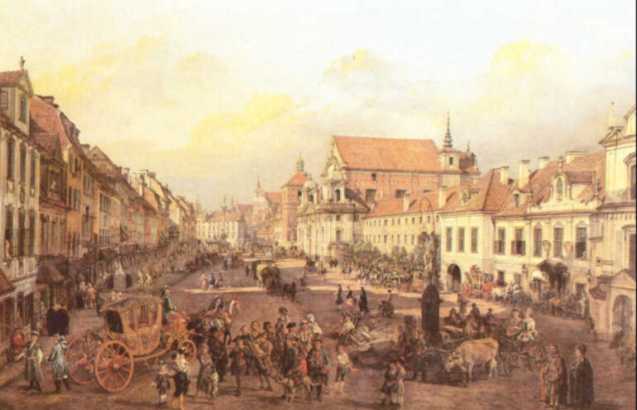
oil, canvas;
National Museum in Warsaw;

Long street
oil, canvas;
National Museum in Warsaw;
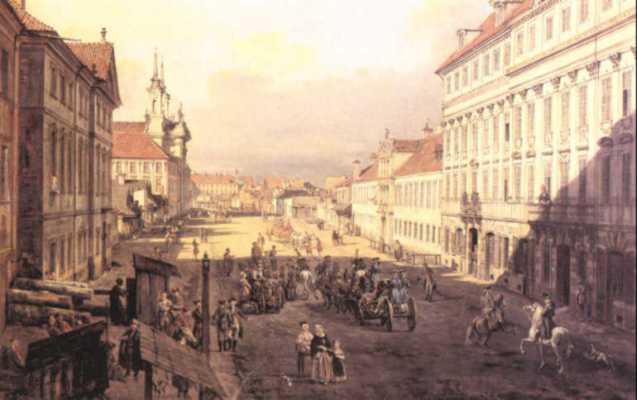
oil, canvas;
National Museum in Warsaw;

Krakowskie Przedmieście from the side of the Krakow Gate
oil, canvas;
National Museum in Warsaw;
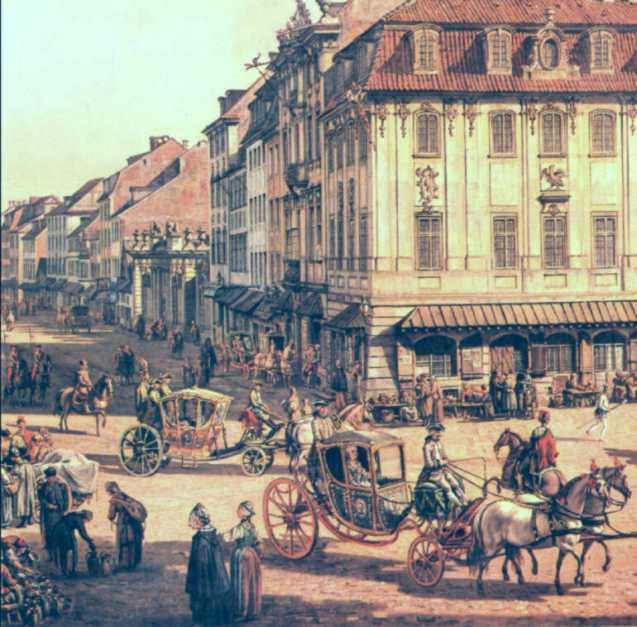
oil, canvas;
National Museum in Warsaw;

Miodowa Street – fragment
oil, canvas;
National Museum in Warsaw;

oil, canvas;
National Museum in Warsaw;

Senatorska Street with the Church of the Reformers, 1779
oil, canvas, 85 x 107 cm;
National Museum in Warsaw;
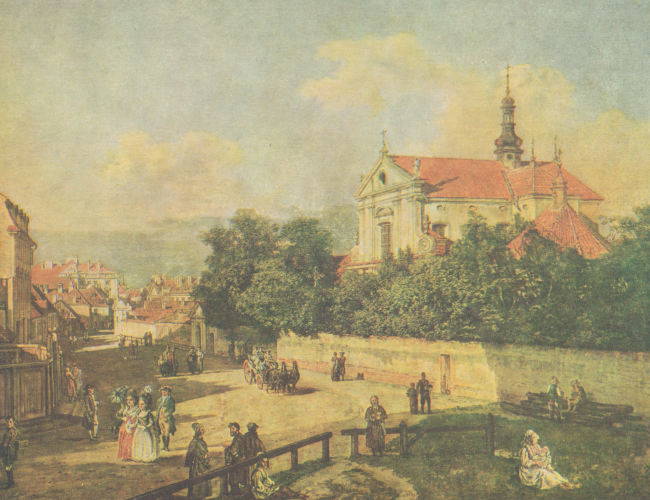
The Baroque Reformed Church was built in 1671-78 (burned in 1944, rebuilt in the years 1948-50). This painting by Canaletto served as one of the sources for its reconstruction.
oil, canvas, 85 x 107 cm;
National Museum in Warsaw;

The Baroque Reformed Church was built in 1671-78 (burned in 1944, rebuilt in the years 1948-50). This painting by Canaletto served as one of the sources for its reconstruction.
Hussar officer on horseback,1773
oil, canvas, 73,5 x 65,5 cm;
Art History Museum, Vienna;

One of the four small equestrian paintings, depicting people from the court circle against the background of fantastic architecture or landscape. An officer of the royal hussars, unknown to us by name, also appears on both versions Stanisław August's election. There is a monogram sewn on the saddle bag, perhaps, artist's signature: F [he drove] B [ernardo] C [analetto]. The other three images are: Colonel Koenigsfel teaches Fr.. Józef Poniatowski i A stable boy leading a horse (both at the National Museum in Warsaw) and Oct. Gintowt on horseback (w 1911 r. was in the collection of Henry Kent in Florence).
oil, canvas, 73,5 x 65,5 cm;
Art History Museum, Vienna;

One of the four small equestrian paintings, depicting people from the court circle against the background of fantastic architecture or landscape. An officer of the royal hussars, unknown to us by name, also appears on both versions Stanisław August's election. There is a monogram sewn on the saddle bag, perhaps, artist's signature: F [he drove] B [ernardo] C [analetto]. The other three images are: Colonel Koenigsfel teaches Fr.. Józef Poniatowski i A stable boy leading a horse (both at the National Museum in Warsaw) and Oct. Gintowt on horseback (w 1911 r. was in the collection of Henry Kent in Florence).
Roman forum, 1769
oil, canvas, 1,16 x 1,73 cm;
Gosudarstwannyj Muzej Izobrazitelnych Iskusstwa im. A.S. Pushkin in Moscow;
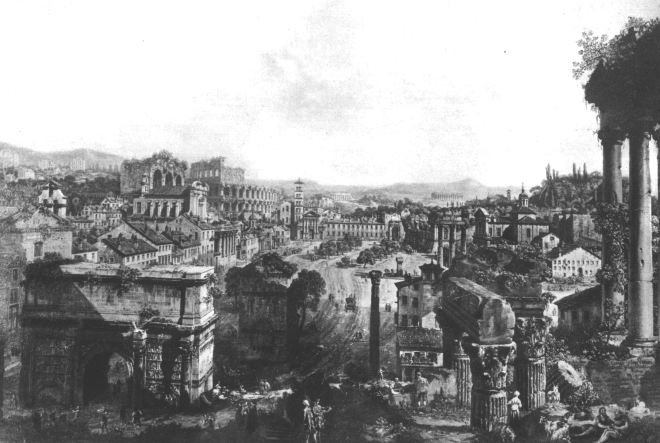
This is a view taken from the Capitol: in the foreground the bow of Septym Severus, the Phocas column and on the right a fragment of the portico colonnade of the Temple of Vespasian and the temple of Saturn on the edge of the painting. In the background, the buildings surrounding the Forum from the north, East and South or adjacent to it, on the left, among others. visible Coliseum. This is one of the 15 views of Rome, mostly painted in 1769 r.
oil, canvas, 1,16 x 1,73 cm;
Gosudarstwannyj Muzej Izobrazitelnych Iskusstwa im. A.S. Pushkin in Moscow;

This is a view taken from the Capitol: in the foreground the bow of Septym Severus, the Phocas column and on the right a fragment of the portico colonnade of the Temple of Vespasian and the temple of Saturn on the edge of the painting. In the background, the buildings surrounding the Forum from the north, East and South or adjacent to it, on the left, among others. visible Coliseum. This is one of the 15 views of Rome, mostly painted in 1769 r.
General view of Warsaw from the Praga side, 1770
oil, canvas, 172,5 x 261 cm;
National Museum in Warsaw;
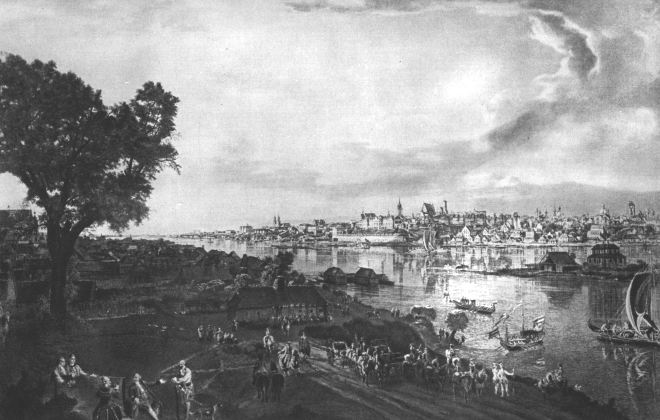
The main image of the series of views of Warsaw. On the other side of the Vistula, starting from the right : New and Old Town, Castle and buildings of the then southern districts; Ujazdowski Castle on the horizon. Modest buildings of Prague in the foreground. The artist also introduced himself here, ending this view, in a conversation with King Stanisław August, who came with the retinue to learn about the progress of work on the veduta. The image is probably supported by Belotto's son-in-law, court royal geographer, Herman Karol de Perthees i syn Lorenzo, anyway, they died in the year the canvas was made. The scene is largely fictional: Bernardo only made drawings by nature, the painting was finished in the studio.
oil, canvas, 172,5 x 261 cm;
National Museum in Warsaw;

The main image of the series of views of Warsaw. On the other side of the Vistula, starting from the right : New and Old Town, Castle and buildings of the then southern districts; Ujazdowski Castle on the horizon. Modest buildings of Prague in the foreground. The artist also introduced himself here, ending this view, in a conversation with King Stanisław August, who came with the retinue to learn about the progress of work on the veduta. The image is probably supported by Belotto's son-in-law, court royal geographer, Herman Karol de Perthees i syn Lorenzo, anyway, they died in the year the canvas was made. The scene is largely fictional: Bernardo only made drawings by nature, the painting was finished in the studio.
Sigismund III's column from the side of the descent to the Vistula, 1768-70
oil, canvas, 1,14 x 1,70 cm;
National Museum in Warsaw;

On the right, it was partially burned in. 1767 Castle wing, on the left the Bernardine Church with adjacent buildings (demolished in the 19th century), on the edge of the bell tower of the St. Bernardine Church. Anny. The only painting of Bellotto without staffage. The same composition was developed in a large-format canvas, animated by staffage, with the king visiting the works on the reconstruction of the burned parts of the Castle (missing in 1939 r.)
oil, canvas, 1,14 x 1,70 cm;
National Museum in Warsaw;

On the right, it was partially burned in. 1767 Castle wing, on the left the Bernardine Church with adjacent buildings (demolished in the 19th century), on the edge of the bell tower of the St. Bernardine Church. Anny. The only painting of Bellotto without staffage. The same composition was developed in a large-format canvas, animated by staffage, with the king visiting the works on the reconstruction of the burned parts of the Castle (missing in 1939 r.)
Honey Street, 1777
oil, canvas, 0,74 x 1,97 cm;
National Museum in Warsaw;

On the left-hand side, the baroque palace of Kraków bishops from the first half of the 19th century. w. XVII, rebuilt in. 1762 (destroyed in. 1944, rebuilt in. 1950), followed by the early-classical palace of banker Tepper from 1774-75, the work of Efraim Szroeger (destroyed in. 1944). On the right, the late-baroque Branicki Palace, built by Jan Zygmunt Deybel from. 1744 (destroyed in. 1939, rebuilt in. 1950). The Krasiński palace in the background, erected in the years 1677-94 by Tylman of Gameren, a leading work of Polish Baroque in the field of secular architecture (largely destroyed in. 1944, rebuilt after the war). This image served as the basic iconographic source for the reconstruction of the palaces of the Krakow and Branicki bishops.
oil, canvas, 0,74 x 1,97 cm;
National Museum in Warsaw;

On the left-hand side, the baroque palace of Kraków bishops from the first half of the 19th century. w. XVII, rebuilt in. 1762 (destroyed in. 1944, rebuilt in. 1950), followed by the early-classical palace of banker Tepper from 1774-75, the work of Efraim Szroeger (destroyed in. 1944). On the right, the late-baroque Branicki Palace, built by Jan Zygmunt Deybel from. 1744 (destroyed in. 1939, rebuilt in. 1950). The Krasiński palace in the background, erected in the years 1677-94 by Tylman of Gameren, a leading work of Polish Baroque in the field of secular architecture (largely destroyed in. 1944, rebuilt after the war). This image served as the basic iconographic source for the reconstruction of the palaces of the Krakow and Branicki bishops.
Election of Stanisław August, 1778
oil, canvas, 1,75 x 2,50 cm;
National Museum in Warsaw;
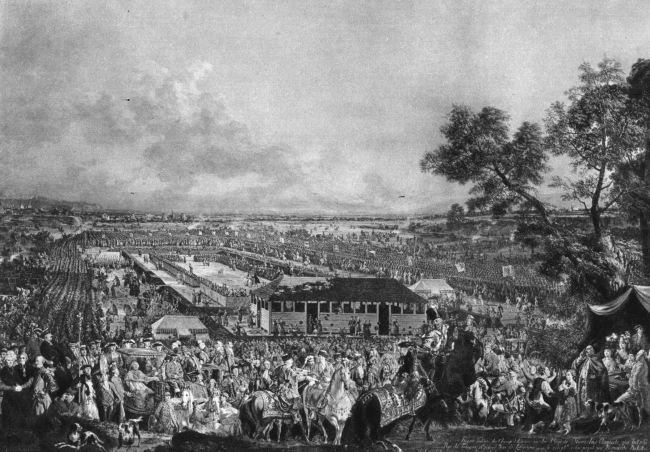
The election of Stanisław August lasted in fact two days – 6 i 7 September 1764 r. The artist presented her climactic points like this, as if it took place on one day. In the middle of the picture, the so-called. shed for senators, tents for foreign missions on the sides. Next, the box rectangle, called the knight's wheel, which are surrounded by representatives of the nobility of individual provinces with their banners. In the foreground, among the cheering crowds on the left, Primate Łubieński, fulfilling the functions of an interrex, in rich phaeton. In the center, the Marshal of the Election Sejm Sosnowski receives the votes of the last voting voivodeship from the voivode of Płock Podoski. There was a commotion in the crowd: the result will be known in a moment. There is a throne chair waiting for the elect in the middle of the field, and in the foreground a steed with a magnificent row; next to him, the courier is getting ready to set off with the news into the world. In fact, some of the details mentioned were not correct, because the elect did not appear on the day of the election to the nobility; the same, of course, it is not true that Canaletto introduces himself to us with three daughters on the right in the corner under the tent, because the painter and his family came to Warsaw only in 1787. This is the second version of the composition, painted by the artist for the first time in 1776: the first version is in the National Museum in Poznań. They both took places in the Canaletto Hall at the Warsaw Castle. In the second version, the painter introduced changes to the arrangement of the characters, and also eliminated some, replacing them with others: It happened, of course, at the request of Stanisław August.
oil, canvas, 1,75 x 2,50 cm;
National Museum in Warsaw;

The election of Stanisław August lasted in fact two days – 6 i 7 September 1764 r. The artist presented her climactic points like this, as if it took place on one day. In the middle of the picture, the so-called. shed for senators, tents for foreign missions on the sides. Next, the box rectangle, called the knight's wheel, which are surrounded by representatives of the nobility of individual provinces with their banners. In the foreground, among the cheering crowds on the left, Primate Łubieński, fulfilling the functions of an interrex, in rich phaeton. In the center, the Marshal of the Election Sejm Sosnowski receives the votes of the last voting voivodeship from the voivode of Płock Podoski. There was a commotion in the crowd: the result will be known in a moment. There is a throne chair waiting for the elect in the middle of the field, and in the foreground a steed with a magnificent row; next to him, the courier is getting ready to set off with the news into the world. In fact, some of the details mentioned were not correct, because the elect did not appear on the day of the election to the nobility; the same, of course, it is not true that Canaletto introduces himself to us with three daughters on the right in the corner under the tent, because the painter and his family came to Warsaw only in 1787. This is the second version of the composition, painted by the artist for the first time in 1776: the first version is in the National Museum in Poznań. They both took places in the Canaletto Hall at the Warsaw Castle. In the second version, the painter introduced changes to the arrangement of the characters, and also eliminated some, replacing them with others: It happened, of course, at the request of Stanisław August.
View of the Wilanów meadows, 1775
oil, canvas, 173 x 246 cm;
National Museum in Warsaw;
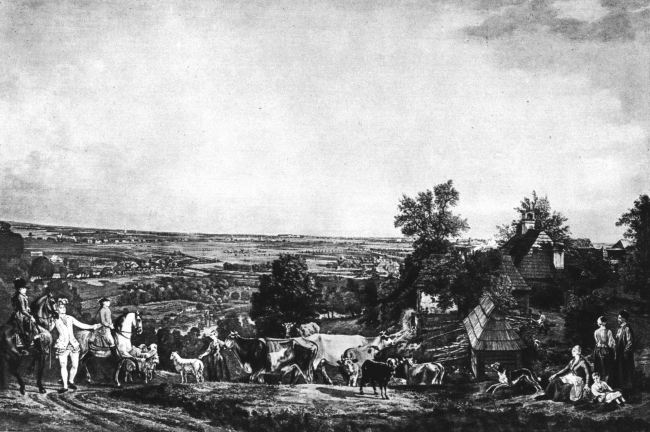
The view taken from the vicinity of the Belwederski Palace towards Czerniaków and Wilanów; the palace and the Wilanów church can be seen in the background.
oil, canvas, 173 x 246 cm;
National Museum in Warsaw;

The view taken from the vicinity of the Belwederski Palace towards Czerniaków and Wilanów; the palace and the Wilanów church can be seen in the background.
Palace in Wilanów from the entrance side, 1776
oil, canvas, 84 x 107 cm;
National Museum in Warsaw;
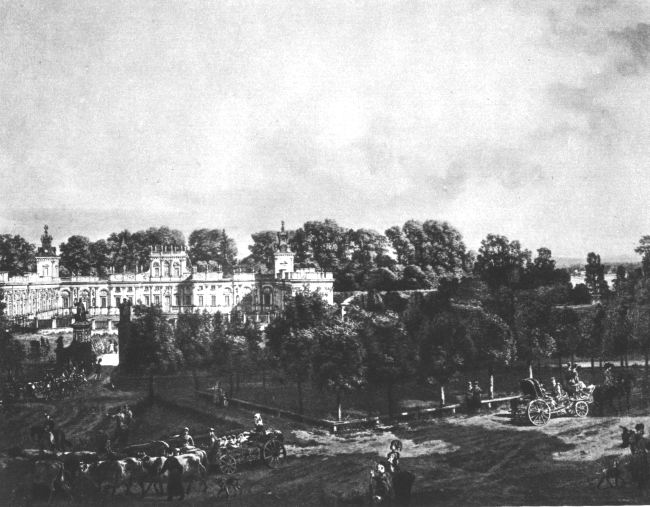
One of the four views of the Wilanów Palace – then the residence of the Lubomirski family near Warsaw, and soon after Potocki – which the artist painted in the years 1776-77. The palace was expanded in 1677-96 by Jan III Sobieski, as his favorite villa ruburbana, from a small brick manor into a residence under the supervision of the architect Augustyn Loccicgo, with sculptural decorations by Szwaner and Schluter. In the 20s and 30s of the 18th century. wings were added to the main body, closing the courtyard of honor on the sides.
oil, canvas, 84 x 107 cm;
National Museum in Warsaw;

One of the four views of the Wilanów Palace – then the residence of the Lubomirski family near Warsaw, and soon after Potocki – which the artist painted in the years 1776-77. The palace was expanded in 1677-96 by Jan III Sobieski, as his favorite villa ruburbana, from a small brick manor into a residence under the supervision of the architect Augustyn Loccicgo, with sculptural decorations by Szwaner and Schluter. In the 20s and 30s of the 18th century. wings were added to the main body, closing the courtyard of honor on the sides.


